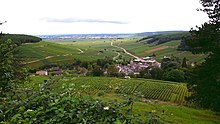Corton-Charlemagne
Corton-Charlemagne is a Grand Cru classified vineyard on the Côte d'Or in the French wine region of Burgundy . It is located in the communes of Aloxe-Corton , Pernand-Vergelesses and Ladoix-Serrigny in the Côte de Beaune . Corton-Charlemagne has its own appellation . Only white wine is produced . Corton-Charlemagne occupies the upper layers of the Montagne de Corton hill of the same name in Ladoix and Aloxe. Despite the size and the different orientation of the vineyards to the sun, the marking ( French : Climat ) must not be mentioned on the label. The site received AOC status on July 31, 1937. The Corton-Charlemagne site shares some parcels with the second Grand Cru site on the hill: Corton . Both locations together cover an area of almost 160.19 hectares and some of them overlap.
The following rules apply:
- The red wine called Corton may be produced on the entire, defined area (see section Climats). The name of the climat may be mentioned on the label for better definition . Only red wines from the Corton-Charlemagne location are excluded from this rule.
- The white wine called Corton may be produced on the entire, defined area (see section Climats). The name of the climat must not be mentioned. The only exception: the Corton-Vergennes wine from the Hôtel-Dieu de Beaune (Hospices de Beaune).
- Some parcels in Aloxe and Ladoix are allowed to produce red and white wines under the name Corton-Charlemagne.
According to Cmille Rodier, the Corton-Charlemagne location can be proven to date back to the year 775 AD. back when Charlemagne (French: Charlemagne) donated the location to the monastery of Saulieu. The situation remained with the Church until the French Revolution.
Climate and geology
The Corton-Charlemagne vineyard is located on a slope at an altitude of 250 to 340 m above sea level . The forest above protects the location from cold winds. The situation is also mostly spared late frosts. The climate is assigned to the Burgundian transitional climate, in which continental influences predominate over maritime ones. The Chardonnay still thrives excellently on the plots above in a south and south-east orientation. Only on the south and south-west facing locations in Aloxe and Pernand-Vergelesse does the Chardonnay benefit from the warmer locations in the lower area of the hill.
The bottom of the Montagne de Corton consists of a thin layer of brown limestone - weathered debris . The vines must drive their roots into the base from the geological age of Bathonium. At a height of 260 m, an approximately 15 m thick layer of Jura rock ( oolite ) is exposed. Geologically it comes from the lower Oxfordium . The upper part has a particularly thin, marl- rich layer.
Wine

The white wines of the Grand Cru Lage are made from the Chardonnay grape variety. The natural alcohol content of the white wines must be at least 12% by volume. The chaptalization is - as everywhere in Burgundy - allowed. The minimum must weight is 187 g / l. The basic yield is 40 hectoliters per hectare, this may be exceeded by a maximum of 20%.
Production quantity
In 2008, a total of 52.44 hectares were declared under the name Corton-Charlemagne. A total of 2237 hectoliters of white wine were produced. This corresponds to a total of almost 300,000 bottles.
Manufacturer and owner
In contrast to the Bordeaux wine region , the vineyards are very small-scale due to the use of inheritance. The largest owner in 2008 was Louis Latour with 9.64 hectares. This was followed by Bonneau du Martray (9.50 ha), Bouchard Père et Fils (3.25 ha), Roland Rapet (2.50 ha), Maratray-Dubreuil (1.62 ha). At least 48 other owners also own shares between 0.17 and 1.60 hectares. The Hospices de Beaune owned 0.7 hectares through various donations.
Climats (the districts)
The following climats belong to the Corton-Charlemagne appellation, but must not appear on the label:
In Aloxe-Corton:
|
|
|
In Ladoix-Serrigny:
- Le Roguet et Corton (the red wine is declared as Corton)
In Pernand-Vergelesses:
- En Charlemagne
Source:
Individual evidence
- ↑ Jancis Robinson: The Oxford Wine Lexicon. Hallwag Verlag, Munich 2007, ISBN 978-3-8338-0691-9 , p. 13.
- ↑ BIVB: Les Appellations d'Origine Contrôlée de Bourgogne (PDF file; 891 kB), accessed on November 3, 2009
- ↑ BIVB: Corton-Charlemagne
- ^ Journal officiel de la République Francaise. (PDF file; 189 kB)
literature
- Clive Coates : The wines of Burgundy . 1st edition. University of California Press, 2008, ISBN 978-0-520-25050-5 .
- Jancis Robinson : The Oxford Wine Lexicon . 1st edition. Gräfe and Unzer Verlag, 2003, ISBN 3-7742-0914-6 .
- Pierre Galet : Cépages et Vignobles de France . 1st edition. Lavoisier Publishing House, Paris, 2004, ISBN 2-7430-0585-8 .
- Benoît France (ed.): Grand Atlas des Vignobles de France . 1st edition. Solar publishing house, Paris, 2002, ISBN 2-263-03242-8 .


